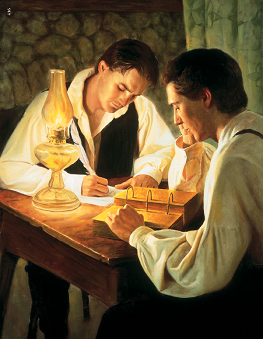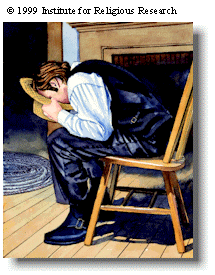I heard and read Smith's own account many times while growing up as a Mormon. I related it to others many times also, both while serving a full-time mission for the church and with non-Mormon family, friends, and acquaintances as a regular member not serving a full-time mission. I am very well acquainted with the official Mormon version of these events. Sometimes believing Mormons think I need to hear about it all over again. The only way they can account for my lack of belief is that I did not quite understand the story. I know the story all too well, but I do not accept it unquestioningly. My lack of acceptance is not related to a lack of familiarity.
Joseph Smith, and the church today, claim that the Book of Mormon is a translation of an ancient record that was engraved on gold plates that were held together in some type of ring binder (see image below).
Smith found the plates buried in a hillside, just where an angel told him to look. Smith's own story about this event can be found on the Mormon Church's official website here.
There is very little in the official church material about the process Smith used to translate. Church artwork sometimes represents the process as Smith reading off the plates while his scribe copies his dictation, as shown below.
Verbal descriptions of the translation process do not agree with this image. For one thing, no one ever saw the plates. Smith kept them concealed (or at least he kept something concealed that he claimed were the plates). First hand accounts describe Smith as putting a seer stone into a hat and covering his face with the hat. The words then would appear in English and he would dictate them to his scribe. The plates were not needed at all.
This discrepancy between the popular image and actual first hand accounts has been a big issue for some who have found their way out of the church. It was not that much of an issue for me, but I understand the problem. The popular image leaves the impression that the plates were out in the open for all to see, which was not the case at all. Apologists acknowledge that the popular image is not correct. The Maxwell Institute at Brigham Young University (formerly FARMS) addresses issues regarding translation here.
So where are the plates now? According to Smith, the angel took them back once the translation process was complete. If anyone did ever see them when Smith supposedly had them, no one has seen them since 1830. In the front of the Book of Mormon are two statements made by witnesses who purportedly saw the plates. The three witness saw them in conjunction with a supernatural experience, while the eight witnesses saw them in an ordinary temporal experience, at least that is what the wording suggests. There is quite a bit of controversy about this. The MormonThink website discusses the witness here while the Maxwell Institute addresses the subject in this article. My own view is that these men wanted to believe so badly and were so suggestible that their minds created the experience. Most of the stories were told many years after the events they describe. Eyewitness testimony and human memory are notoriously unreliable. Other issues about the Book of Mormon are of sufficient magnitude that the testimonies of the witnesses do not make up for it in my view.
If Joseph Smith did not really translate an ancient record, how did he, as an unschooled farm boy, produce something like the Book of Mormon? That is a question most believing Mormons think cannot be answered satisfactorily. I will address alternate ideas about Book of Mormon origins in my next post.




No comments:
Post a Comment